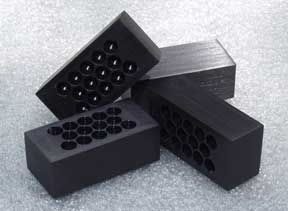

Overview and Theory
Now discontinued, the original rectangular SuperCouplers were made from the same 3/4 X 1 X 2 inch 7075 aluminum as the Large Coupler and the Series 2 Rollerblock, the Supercoupler borrowed from the Rollerblock design to deliver improved coupling efficiency to surfaces for better energy transfer. Lacking only the Rollerblock's precision, polished cup and the acoustic foam in its matrix, the Supercoupler was supplied with the Quantum Platform. The performance potential of the Quantum demanded a leap forward in coupler technology, and the patented coupling technology of the Rollerblocks provides this advantage. The Supercoupler has been replaced by the new Precision Supercoupler.
Hard Coat Anodizing
The Supercoupler consisted of a section of hard coat anodized 7075 aircraft alloy aluminum. As in the Rollerblock, this anodizing process differs from the "garden variety" anodizing (usually black in color) found on most electronic components in that it causes a profound change in the hardness of the surface of the aluminum, creating a "skin" which is harder than most steels. Typical surface hardness with this process is on the order of chromium steel or greater; the ordinary black anodized finish (such as on CD players, etc.) is little more than a surface dye or coloration. The hard-coat skin of the Supercoupler, as in the Rollerblock, serves two purposes: first, it constrain-layer damps the surface of the aluminum alloy body, making it less prone to self-resonance and making it appear harder to the interfacing surface, and second, it acts as a higher-density layer which enables faster transmission of mechanical energy, enabling better drainage of energy at higher frequencies. In principle, its purpose is to take advantage of mechanical "skin effect" at the higher frequencies of transmitted mechanical vibration.
The Matrix
The bottom of the Supercoupler has a "matrix" pattern of holes, along with beveled edging. As in the Rollerblock, this "matrix" serves both as a crude waveguide which enhances the penetration of mechanical energy into the support surface by presenting a more optimal angle interface (see the "Our Technology" section", and also increases contact pressure to the supporting surface, affecting superior energy transmission.
Deployment
One Supercoupler should be placed on each of the Quantum's quadrant sections, thus coupling each section to a different part of the component's chassis. The matrix can face up or down.